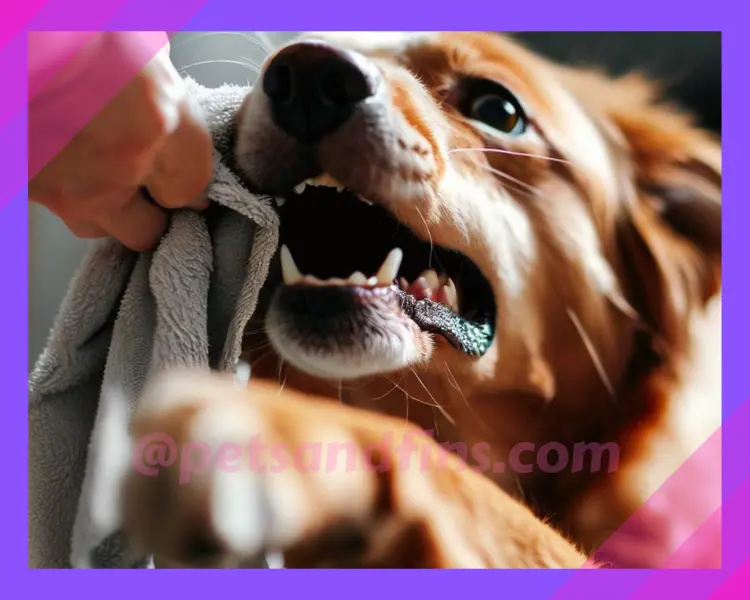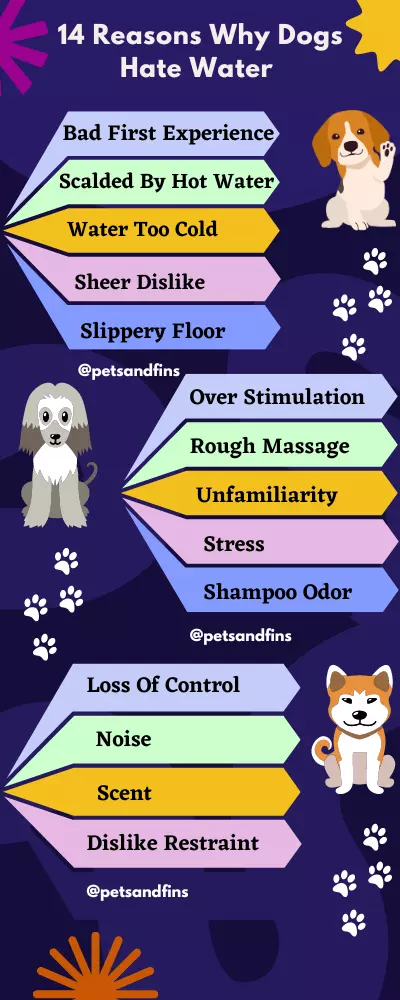In this article, we will explore the top “14 Reasons Why A Dog Can Hate A Bath. From fear of water to sensitive skin, we’ll cover the most common reasons why dogs may dread bath time.
Bath time is a necessary part of pet care, but not all dogs enjoy it. Some dogs may become anxious, stressed, or even aggressive when it’s time for a bath. As a pet owner, it can be challenging to understand why your dog hates bath time and how to make the experience more pleasant for them.
Whether you’re a new dog owner or an experienced pet parent, this article will provide valuable insights and strategies to help you and your dog navigate bath time with ease.
14 Reasons Why A Dog Can Hate A Bath

1. A Bad First Experience
It’s not uncommon for dogs to hate baths, and one reason for this may be due to a bad experience in the past. If they had a negative experience with a particular scent or a rough handling during their previous bath, they may associate the experience with fear and discomfort. This can cause them to resist or become anxious during future baths, making the process difficult for both the pet and the owner.
2.Scalded By Hot Water
Dogs can develop a fear of baths for a variety of reasons, and one of the most traumatic experiences a dog can have during bath time is being scalded by hot water. Just like humans, dogs have sensitive skin and can be easily burned by water that’s too hot. The experience of getting scalded can leave a lasting impact on a dog’s perception of baths, making them fearful whenever they come near water.
3.Water Too Cold
If a dog has ever been bathed in water that was too cold, it may develop a negative association with water. Cold water can be uncomfortable and even painful for dogs, and the shock of being suddenly exposed to or immersed in it can be quite a memory. A past incident of being bathed in cold water can lead the dog to try avoiding bath time.

4. Sheer Dislike
Sometimes, a dog may dislike baths for no specific reason at all. Dogs are complex creatures with unique personalities, and their likes and dislikes can be influenced by a wide range of factors, including past experiences, temperament, and individual preferences.
Some dogs simply do not enjoy the sensation of being wet or the confinement of being in a small tub.
5. Slippery Floor
Dogs naturally rely on their paws for stability and traction. Dogs can be afraid of slipping on slippery surfaces, and this can make them dislike bath time if the floor is slippery.
The combination of soap and water can make the floor of a bath or shower slick, and this can cause a dog to feel anxious and unsteady. This fear of slipping can also cause them to struggle or resist, making the bathing process more difficult for both the dog and the owner.

6. Over Stimulation
Dogs can become overstimulated during bath time, leading to fear or discomfort. that can make them resist or avoid the experience altogether. The combination of running water, shampoos, soaps, and the physical sensation of being scrubbed can create a sensory overload for some dogs, leading to stress and anxiety.
Overstimulation can cause a dog to feel overwhelmed, making it difficult for them to remain calm and cooperative during bath time.
7. Rough Massage
A rough or uncomfortable massage during bath time can be a reason why some dogs develop a negative association with baths. Dogs have sensitive skin, and a rough massage can cause discomfort or even pain, leading to fear or avoidance of bath time.
Additionally, some dogs may not enjoy the sensation of being handled or restrained, especially if they have had negative experiences with being groomed or bathed roughly in the past.

8.Unfamiliarity
If a dog is unfamiliar with the process of being bathed, it’s not uncommon for them to develop discomfort or dislike of the experience. For some dogs, the sound and sensation of running water, the confinement of a small space, and the unfamiliarity of being handled by a person can be overwhelming and stressful. The unfamiliarity can trigger anxiety, leading to a strong aversion towards bath time.

9. Stress
A dog can develop a dislike for baths if the overall experience creates stress for them. Bath time can be a stressful experience for dogs, especially if they have had negative experiences with bathing in the past. This stress can manifest in various ways, such as panting, shaking, hiding, or even aggression.
10.Shampoo Odor
A dog can develop a dislike for baths if they dislike the texture or smell of the shampoo used during the bath. Dogs have a keen sense of smell and can be sensitive to the scents used in their grooming products.
Additionally, some dogs may not like the feel of certain shampoos on their skin or fur, leading to discomfort or even irritation. To help a dog feel more comfortable during baths, it’s important to select a high-quality, hypoallergenic shampoo that is specifically designed for dogs.
11.Loss Of Control
Dogs are man’s best friend, but when it comes to bath time, they can become our worst enemy. Have you ever wondered why dogs hate baths so much? It’s because they do not like losing control of the situation. Dogs are naturally curious and independent animals, and when we force them into a bath, we take away their autonomy.
Remember that dogs have feelings too, and forcing them into an uncomfortable situation will only make things worse. So next time you give your dog a bath, try to understand their perspective and make the experience as pleasant as possible for both of you.

12.Noise
Dogs have incredibly sensitive hearing, and loud noises can be overwhelming and scary for them.
When it comes to bath time, many dogs associate the sound of running water and the splashing of bubbles with negative experiences. This can lead to anxiety and fear, making it difficult for them to relax during bath time.
By creating a peaceful environment for our dogs during bath time, we can help them overcome their fear or aversion and make the experience more enjoyable for everyone involved. So next time you give your furry friend a bath, remember that a little peace and quiet can go a long way in making them feel comfortable.
13.Scent
As a dog owner, you may have experienced the struggle of giving your furry friend a bath. Some dogs seem to love it, while others absolutely hate it. But did you know that a dog’s dislike for baths can be linked to the scent of the shampoo?
Just like humans, dogs have their own unique preferences and sensitivities when it comes to smells. If your dog dislikes the scent of their shampoo, they may associate it with negative experiences and become anxious or agitated during bath time.
It’s important to choose a shampoo that is specifically formulated for dogs and has a mild scent that won’t overwhelm their sensitive noses. Additionally, try introducing your dog to the scent before bath time by letting them smell the shampoo bottle or using it as a room spray.
14. Dislike Being Restrained
Some dogs can hate it if they dislike being restrained with a leash.
Dogs are naturally curious creatures who love to explore their surroundings. When we force them into a small space like a bathtub or shower stall, they may feel trapped and anxious. This can lead to fear and resistance when it comes time for their next bath.
One way to make bath time more enjoyable for your dog is by using positive reinforcement techniques.
Once you understand why dogs hate a bath, you will also need to know what you should do about it. Here below is an article exclusively on that aspect with 23 tips on bathing dogs who hate water or a bath. https://petsandfins.com/how-to-bathe-a-dog-who-hates-water/
In My Personal Experience
In my personal experience, I’ve found that brushing your dog in the bathing area and then following up with a gentle wipe using a slightly wet towel can be an effective way to keep your furry friend clean and comfortable.
It’s important to approach this process with a calm and patient demeanor, ensuring a positive experience for both you and your dog. To slowly introduce water, I recommend pouring it near the legs using a mug, allowing the water to flow below the legs without directly pouring it on the dog.
This gradual approach can help your dog acclimate to the sensation of water and make bath time more enjoyable. By repeating this process a few times and progressively wetting the legs, you can help your dog become more at ease during baths and maintain good hygiene.
Summary
In conclusion, it is clear that dogs’ aversion to water can stem from a variety of factors, both instinctual and experiential. While some dogs may have a natural dislike for water due to their breed’s history or genetic makeup, others may have had negative experiences or lack exposure to water during their critical socialization period.
Additionally, certain physical or psychological factors such as fear, anxiety, or past trauma can contribute to a dog’s aversion to water. However, it is important to note that not all dogs hate water, and many can be trained or gradually introduced to water activities in a positive and supportive manner.
With patience, understanding, and proper training techniques, dogs can learn to overcome their fears and develop a healthier relationship with water. Ultimately, every dog is unique, and it is crucial to respect their individual preferences and comfort levels when it comes to water-related activities.
If you would like to read more about this – here is another article.
How to Bathe a Dog the Right Way, According to a Pet Expert
Puppy Traumatized After Bath

If your puppy is traumatized after a bath, there are several things you can do to help them overcome their fear.
First, it is important to understand that a traumatic experience can have lasting effects on a puppy’s behavior and overall well-being. Therefore, it is essential to approach the situation with empathy, patience, and consistency.
One effective way to help your puppy overcome their fear is to gradually reintroduce them to the bath. Start by offering treats or toys in the bathroom and allowing them to sniff around and explore the area. This will help them associate positive experiences with the bath environment.
You can then slowly introduce water, using a damp washcloth or a low-pressure hose. It is essential to avoid pouring water over their head, as this can be overwhelming and frightening for a traumatized puppy.
Additionally, it is essential to use a gentle shampoo and avoid getting soap in your puppy’s eyes, ears, and nose.
Consistency is key when helping a traumatized puppy overcome their fear of the bath. Make bath time a regular part of their routine, so they become accustomed to it and know what to expect.
Avoid rushing the process and be patient with your puppy, as it may take some time for them to feel comfortable.
If your puppy’s fear of the bath persists, it may be helpful to consult with a professional dog trainer or behaviorist. They can provide additional strategies and support to help your puppy overcome their fear and lead a happy, healthy life.
Remember, it is essential to approach the situation with empathy and understanding, as traumatized puppies need extra love and care to feel safe and secure.
My Dog Hates Water But Needs A Bath

Bath time can be a daunting experience for many dogs, especially those who dislike water. As a pet owner, it can be challenging to convince your dog to take a bath, but proper hygiene is essential for their overall health and well-being.
If your dog hates water but needs a bath, there are several steps you can take to make the experience more pleasant and less stressful for both you and your furry friend.
First, it is essential to understand why your dog may dislike water. Some dogs may have had negative experiences in the past, such as being sprayed with a hose or falling into a pool, which can create a fear of water.
Others may have sensitive skin, making it uncomfortable for them to be wet. Some breeds, such as those with thick fur, may find it difficult to dry off, leading to discomfort and even skin infections.
Regardless of the reason, it is crucial to approach the situation with empathy and patience, as forcing your dog to take a bath can be traumatic and harmful to their mental and physical health.
The first step in convincing your dog to take a bath is to create a positive association with the bath area. Start by placing treats, toys, and a comfortable blanket near the bathtub or shower.
Warm water is preferable, but make sure it’s not too hot, as this can be uncomfortable and even burn your dog’s skin. It’s important to have all the necessary bathing supplies nearby, such as towels, a brush, and a non-slip mat, to avoid slipping and injury.
During the bath, it’s crucial to remain calm and patient. Use a gentle, reassuring voice and avoid forcing your dog into the water. Instead, use a damp washcloth or a low-pressure hose to wet their fur.
Start at their feet and gradually work your way up, avoiding their head. You can also use a cup or bucket to pour water over their back, taking care to avoid their face.
Be sure to rinse thoroughly to avoid leaving any soap on their skin, which can cause irritation and discomfort.
After the bath, it’s essential to dry your dog thoroughly. Use a towel to remove excess water, and then use a hairdryer on the lowest setting to dry their fur. Be sure to keep the dryer at a safe distance from your dog’s skin to avoid burning them.
You can also use a brush to detangle any knots or mats in their fur.
In conclusion, convincing a dog who hates water to take a bath can be a challenging task, but it is necessary for their overall health and well-being.
By creating a positive association with the bath area, using the right shampoo and water temperature, and remaining calm and patient during the bath, you can help your dog feel more comfortable and relaxed during the process.
Do Dogs Like Being Clean After A Bath

As a dog owner, you might have wondered if your furry friend enjoys being clean after a bath.
Dogs’ opinions on liking to be clean after a bath can vary greatly depending on their individual personalities and past experiences. While some dogs may thoroughly enjoy the sensation of being clean and fresh after a bath, others may not share the same enthusiasm.
Dogs have a unique sense of smell, and bathing can temporarily remove their natural odor, which serves as a way of communication and comfort among their canine counterparts. Some dogs may feel a bit disoriented or insecure after a bath due to the unfamiliar scent.
However, for many dogs, the physical relief of having dirt and grime washed away can be quite pleasant. Additionally, some dogs may appreciate the attention and bonding time spent with their human during the bathing process.
Ultimately, whether a dog likes being clean after a bath depends on their individual preferences and experiences, and it is important for pet owners to observe and respect their furry friend’s reactions to ensure a positive bathing experience.
Why Do Dogs Hate Water?

Water is an essential part of life, but for some dogs, it seems to be their arch-nemesis. Many pet owners have experienced the struggle of trying to convince their furry friend to take a bath or go for a swim.
But have you ever wondered why dogs hate water? Let’s delve into some of the possible reasons behind this common canine aversion.
Negative experiences: Like humans, dogs can develop fears and aversions based on negative past experiences. If a dog has had a traumatic incident involving water, such as being caught in a strong current or being sprayed unexpectedly, it can create a lasting fear of water. These negative associations can be difficult to overcome and may lead to a dog’s aversion to water.
Lack of exposure: Some dogs simply have limited exposure to water from a young age. If a dog has not been introduced to water in a positive and gradual manner during their critical socialization period (usually between 3 to 14 weeks of age), they may develop apprehension or fear towards it. Early positive experiences with water can help dogs become more comfortable and confident around it.
Breed predispositions: It’s important to consider breed tendencies when discussing dogs’ aversion to water. Certain breeds have a natural inclination to dislike water. For example, many small or toy breeds, such as Chihuahuas or Maltese, have a low tolerance for water due to their size and body structure.
On the other hand, some breeds are bred specifically for water-related tasks, such as retrieving waterfowl. Retrievers, like Labradors and Golden Retrievers, are typically more water-loving due to their genetic heritage.
Sensitive skin or discomfort: Dogs with sensitive skin or underlying skin conditions may find contact with water uncomfortable or irritating. The sensation of wet fur and prolonged moisture can lead to itchiness, dryness, or even skin infections.
In such cases, dogs may associate water with discomfort, leading to a dislike for it.
Fear of the unknown: Dogs are creatures of habit and can be wary of unfamiliar or unpredictable situations. The sight, sound, and feel of water can be overwhelming for some dogs, causing anxiety or fear.
The splashing, noise of running water, or the sensation of being submerged can trigger a fight-or-flight response, leading to a strong aversion to water.
Lack of confidence or poor swimming skills: Dogs that haven’t been exposed to water gradually or taught how to swim properly may lack confidence in the water.
If they haven’t learned how to balance, paddle, and propel themselves effectively, they may feel insecure and anxious when near bodies of water.
Temperature sensitivity: Dogs, especially those with short coats or minimal body fat, may be more sensitive to extreme temperatures, both hot and cold.
Cold water can be uncomfortable or even painful for them, while excessively hot water can lead to burns or discomfort. These temperature-related issues can contribute to their aversion to water.
While dogs may have a natural aversion to water for various reasons, it’s important to respect their boundaries and individual preferences. Forcing a dog into water or overwhelming them with a sudden bath can intensify their fear or anxiety.
Instead, it’s crucial to approach water-related activities with patience, positive reinforcement, and gradual exposure.
If you’re looking to help your dog become more comfortable with water, consider introducing them to it in a controlled and positive manner.
Start with shallow water and allow them to explore at their own pace. Use treats, toys, and praise to associate water with positive experiences.
Additionally, providing them with a life vest can help build confidence and security during swimming activities.
In some cases, professional assistance from a certified dog trainer or behaviorist may be necessary to address severe water aversion.
Why Do Dogs Hate Baths But Love Swimming

Many dog owners have experienced the struggle of giving their furry friend a bath, while their dog eagerly jumps into any body of water for a swim. It’s natural to wonder why dogs seem to hate baths but love swimming. Let’s explore some of the reasons behind this apparent contradiction.
Association: Dogs are associative learners, which means that they form connections between different experiences, sights, sounds, and smells. Many dogs associate the act of taking a bath with an unpleasant experience, such as getting sprayed with water or having their eyes and ears cleaned.
In contrast, swimming is often associated with fun and play, as it usually occurs in a natural setting like a lake or river.
Water Depth: Dogs may feel more comfortable in deeper water, such as when swimming, as it allows them to move more freely and easily. A bathtub or shower, on the other hand, is typically shallow and restrictive, making it more difficult for dogs to move around and feel comfortable.
Temperature: Bathwater is usually warm, which can be uncomfortable for dogs with a thick coat, as they may overheat or feel suffocated. In contrast, swimming in cooler water can be refreshing and invigorating, especially on a hot day.
Scent: Dogs have a keen sense of smell and are attracted to different scents. Some dogs may find the scent of soap or shampoo used during a bath unpleasant or overwhelming. In contrast, the scent of natural bodies of water like a river or lake can be alluring to dogs, as it contains scents from other animals, plants, and microorganisms.
Sensory input: Dogs are sensory creatures and often enjoy experiencing different textures, sounds, and sights. Swimming in a natural setting provides dogs with a diverse range of sensory input, such as the sound of water, the feel of different surfaces underfoot, and the sight of fish or other wildlife. In contrast, a bath in a tub or shower provides limited sensory input.
Exercise: Swimming provides dogs with an excellent opportunity for exercise and play. Swimming is a low-impact activity that can be a great way to burn off energy and stay physically fit. A bath, on the other hand, is not typically associated with exercise or play and can be a more restrictive experience for dogs.
Natural instinct: Some dog breeds have a natural instinct to swim. Breeds such as Retrievers, Spaniels, and Water Dogs were historically bred for water-related tasks such as retrieving waterfowl, making them naturally inclined to enjoy swimming. Other breeds, such as Terriers, were bred for activities such as hunting small game and may have less of an inclination for swimming.
In conclusion, dogs may hate taking a bath but love swimming due to a variety of factors, including association, water depth, temperature, scent, sensory input, exercise, and natural instinct. As responsible pet owners, it’s important to respect our dogs’ individual preferences and work with them to create positive associations with baths and other water-related activities. By providing dogs with gradual exposure, positive reinforcement, and patience, we can help them learn to enjoy all kinds of water-related experiences.
References
American Kennel Club (AKC). (n.d.). How Often Should You Bathe Your Dog? Retrieved from https://www.akc.org/expert-advice/health/how-often-should-you-bathe-your-dog/
PetMD Editorial. (2021). How Often Should I Bathe My Dog? Retrieved from https://www.petmd.com/dog/grooming/how-often-should-i-bathe-my-dog
